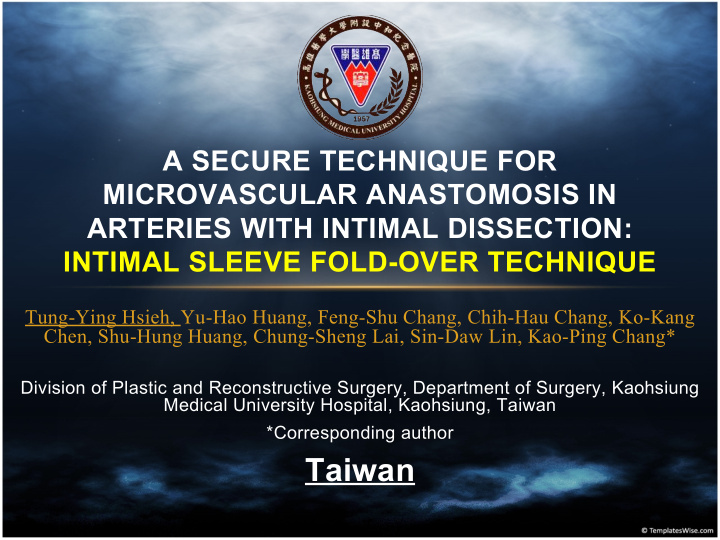



A SECURE TECHNIQUE FOR MICROVASCULAR ANASTOMOSIS IN ARTERIES WITH INTIMAL DISSECTION: INTIMAL SLEEVE FOLD-OVER TECHNIQUE Tung-Ying Hsieh, Yu-Hao Huang, Feng-Shu Chang, Chih-Hau Chang, Ko-Kang Chen, Shu-Hung Huang, Chung-Sheng Lai, Sin-Daw Lin, Kao-Ping Chang* Division of Plastic and Reconstructive Surgery, Department of Surgery, Kaohsiung Medical University Hospital, Kaohsiung, Taiwan *Corresponding author Taiwan
Disclosure of Relevant Financial Interests for All Authors: “Nothing to disclose.” Tung-Ying Hsieh, MD, Address: Division of Plastic and Reconstructive Surgery Kaohsiung Medical University Hospital 100 Shih-Chuan 1st Road Kaohsiung 807, Taiwan Tel: (O) 886-7-3121101 Ext 7675 Fax: (O) 886-7-3111482 E-mail: photopigment@gmail.com
Background Background • Intimal dissection can cause an irregular internal surface with intimal flaps and subendothelial collagen exposure. This has been associated with a high risk of thrombosis. • Trimming the artery to a healthy level is routinely recommended to avoid intimal dissection. However, this method is limited when there is inadequate vascular length to work with. Tung-Ying Hsieh E-mail: photopigment@gmail.com
Methods Methods • We dealt with an artery exhibiting severe intimal dissection by using a new suture technique: the intimal sleeve fold-over technique (Figure 1&2). • Severe arterial initimal dissections were observed in 6 of 130 (4.6%) arterial microvascular anastomoses in free flap reconstruction for oral cancer patients from January 2013 to December 2013. Tung-Ying Hsieh E-mail: photopigment@gmail.com
Step 1: Step 1: Circumferential excision of the media layer Circumferential excision of the media layer • We removed a small end portion of the media layer circumferentially to expose the intima. The goal was to fold the intima layer inside out; thus, we sufficiently trimmed the media layer circumferentially. • This was easily accomplished without injuring the intima because the dissection of the media and intima layers were clearly discernible. Tung-Ying Hsieh E-mail: photopigment@gmail.com
Step 1: Step 1: Circumferential excision of the media layer Circumferential excision of the media layer Tung-Ying Hsieh E-mail: photopigment@gmail.com
Step 2: Fold-over intimal sleeve Step 2: Fold-over intimal sleeve • We simply folded the intima over the media, similar to folding over a shirt sleeve. This allowed the 2 layers of tissue to remain in close contact. Tung-Ying Hsieh E-mail: photopigment@gmail.com
Step 2: Fold-over intimal sleeve Step 2: Fold-over intimal sleeve Tung-Ying Hsieh E-mail: photopigment@gmail.com
Step 3: Anastomosis Step 3: Anastomosis • A normal vascular anatomy was obtained using the fold-over technique by tenting the undulating intima to the media. We performed microvascular anastomosis, similar to normal vascular anatomy, which produced minimal turbulence and anastomosis failure. Tung-Ying Hsieh E-mail: photopigment@gmail.com
Step 3: Anastomosis Step 3: Anastomosis Tung-Ying Hsieh E-mail: photopigment@gmail.com
Results Results • All six patients were discharged as scheduled without perioperative problems and complications during following up. • The mean diameter of the recipient and pedicle arteries with intimal dissection were 2.13 and 2.20 mm. • The mean time for performing sleeve fold-over procedure of on each artery was 5.1 min. Tung-Ying Hsieh E-mail: photopigment@gmail.com
Conclusions Conclusions • A secure intima-to-intima contact can be achieved using this technique. This technique can provide an alternative method to intimal dissection when the length of the artery is limited. Tung-Ying Hsieh E-mail: photopigment@gmail.com
Figure 1 Figure 1 Tung-Ying Hsieh E-mail: photopigment@gmail.com
Figure 2 Figure 2 Tung-Ying Hsieh E-mail: photopigment@gmail.com
Recommend
More recommend